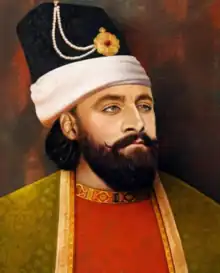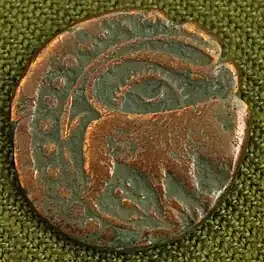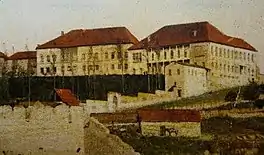Panah Ali Khan | |
|---|---|
 Modern illustration of Panah Ali Khan | |
| Khan of Karabakh | |
| Reign | 1748–1760 |
| Successor | Mehrali bey Javanshir |
| Born | 1693 Safavid Karabakh, Safavid Empire |
| Died | 1763 (aged 69–70) or 1759 (aged 65–66) Shiraz, Zand dynasty |
| Noble family | Javanshir clan |
| Issue | Ibrahim Khalil Khan Mehrali bey Javanshir |
| Father | Ibrahim agha Javanshir |
Panah Ali Khan Javanshir (Persian: پناهعلی خان جوانشیر; Azerbaijani: پناهعلی خان; 1693 – 1759 or 1763) was the founder and first ruler of the Karabakh Khanate under Persian suzerainty.[1][2]
Ancestry
Panah Ali Khan was from the Sarijali branch of the clan of Javanshir, who with their associate clan of Otuz-Iki (meaning thirty-two in Azerbaijani) had for long been rivals of the Yirmi-Dört (meaning twenty-four in Azerbaijani) and Ziyadoghlu Qajars of Ganja, whose chiefs had been official rulers of Karabakh since Safavid times.[3] His father's name was Ibrahim Agha Javanshir but information on his further ancestry is quite complicated.
According to Mirza Adigozal bey, Panah Ali's paternal great-grandfather and namesake Panah Ali bey served at the headquarters of the governors (beglarbegs) of the Karabakh-Ganja province in the early 17th century, at the time when the region was directly controlled by the Safavid Empire of Iran. He soon retired, married a woman from the Javanshir clan of Karabakh and had a son by the name of Ali (nicknamed Sarija Ali). They lived in their estate located in Arasbar (Arasbaran) but also owned land in Tartar and the northern shores of the Aras River. The Arasbar estate was rebuilt into a castle during Sarija Ali's son Ibrahim Khalil's lifetime and has been known as Ibrahim Khalil Galasi since.[4]
However, the aforementioned information is contested by different sources, namely Mir Mehdi Khazani who names Panah Ali khan's grandfather as Ibrahim Sultan (head of tribe c. 1672) and great-grandfather as Budagh Sultan (head of tribe c. 1628). Azerbaijani historian E. B. Shukurzade proposes Panah Ali Agha (I) as his grandfather and Ibrahim Khalil Agha (I) as his great-grandfather. However, in all versions his father is the same.[5] Panah Ali had two brothers, elder Fazlali bey, and younger Behbud Ali bey.
Early life
After the dethronement of the Safavids in 1736 by Nader Shah, the landed classes of Ganja and Karabakh (including the Javanshirs) gathered in Mughan and decided to oppose the new shah and agreed to try to restore the Safavids to the throne. When this news reached Nader Shah, he ordered all Muslim landowners of the region and their families deported to Khorasan (northeastern Iran) as punishment. Panah Ali was among the deportees.[4] His elder brother and former master of ceremonies (Azerbaijani: eşikağası) of Nader, Fazlali bey, was murdered c. 1738. This was when Panah Ali found himself displeased with Nader Shah's attitude towards him. In 1747, having gathered many of those previously deported from Karabakh in 1736, Panah Ali returned to his homeland. The shah sent troops to bring back the runaway, but the order was never fulfilled, as Nader Shah himself was killed in Khorasan in June of the same year. The new ruler of Persia, Adil Shah, issued a firman (decree) recognizing Panah Ali as the Khan of Karabakh.[4]
Reign
Adil Shah's murder in 1748 left Panah Ali virtually independent. He campaigned against the Five Melikdoms of Karabakh as part of his plan to solidify his rule in Karabakh. He forged an alliance with new Melik of Varanda, Melik Shahnazar II, who had recently killed his uncle or elder brother Hovsep and usurped rule. Melik Shahnazar II's daughter Hurizad was wed to Panah Ali's son Ibrahim Khalil and the melik swore fealty to the khan. The other meliks forged an alliance and raided Shahnazar's lands but couldn't take his fortress in Avetaranots.

Taking advantage of the power vacuum in the region, Panah Ali campaigned to the west and south against the khanates of Nakhchivan and Karadagh, taking Tatev and Sisian from the former and Bargushat, Meghri and Göynük from the latter. He also conquered Ghapan and Zangezur from Ebrahim Afshar. To the north, he subdued the Kolani tribe living on the shores of the Tartar River. He also invited a part of the Kangarlu tribe from Nakhchivan as well as the Damirchi Hasanlu and Jinli tribes from Georgia to settle in his territory. This was also when Bayat Fortress was built as the khan's first residence. In a short period, external walls were constructed, ditches were dug out, and a bazaar, bath and mosque were built. Craftsmen from surrounding areas were resettled in the castle. Many residents of the area, especially craftsmen of the Tabriz district and Ardabil, moved to Bayat Fortress with their families.[6] Panah Ali Khan's growing power faced resistance from the Khanate of Ganja, the Khanate of Shaki and from the remaining Melikdoms of Karabakh, as well as rival branches of the Javanshir clan. The struggle between the khan of Karabakh and Haji Chalabi Khan of Shaki, one of the most powerful rulers of the South Caucasus, started the same year. Haji Chalabi Khan, wishing to stop the growth of Panah Ali Khan's power, allied with Hajji Muhammad Ali Khan of Shirvan and surrounded the castle of Bayat. The allies unsuccessfully tried to capture the capital of the Karabakh Khanate for a month. The khans of Shaki and Shirvan withdrew, incurring huge casualties and failing to accomplish their mission. Haji Chalebi Khan said: "Until now Panah Khan was raw silver that was not minted. We came, minted it, and returned."[4] Another 19th century Karabakh historian, Mirza Yusif, renders the same line as: "Until now Panah Khan was merely gold, we came and minted a coin from that gold."[7]
Panah Ali was forced to abandon Bayat and constructed Shahbulag Castle instead. Using the power vacuum in Persia, he acted to subdue neighboring regions as well. He moved on Nazarali Khan Shahsevan of Ardabil in 1749 and forced him to marry his sister Shahnisa to his own son Ibrahim Khalil and accept vassalage. The same year he attacked Shahverdi Khan of Ganja and subdued him, forcing Shahverdi's daughter Tuti to marry Ibrahim Khalil as well. According to Mirza Adigozal bey, he also kept his sons as hostage in Shahbulag. However, emergence of new Qajar warlord Muhammad Hasan Khan forced Panah Ali to seek a new fortress. On the advice of Melik Shahnazar II, he built Shusha Castle in 1750-1751 and relocated his capital, thus settling a semi-nomadic populace in the quarters of the new city.

Campaign against Shaki
Next year, in 1752, Teymuraz II of Kakheti attacked Ganja and forced Panah Ali to retreat from area. Teymuraz then allied himself to Haji Chalabi of Shaki to raid Djaro-Belokani, only to be betrayed by the latter, who defeated the Georgian army. Using this opportunity, Panah Ali allied himself with Shahverdi Khan of Ganja, Kazim Khan of Karadagh, Hasan Ali Khan of Erivan, Heydarqoli Khan of Nakhchivan against Haji Chalabi of Shaki the same year and invited Heraclius II of Georgia to their alliance. During the negotiations near Qızılqaya, the Georgian detachments, hiding in ambush, surrounded and captured five khans along with their retinue. Haji Chalabi, having learned about the conspiracy of Heraclius II, gathered an army and began to pursue Heraclius, attacked him and defeated him in the battle at the river Aghstafa, having freed all the captured khans. Haji Chalabi later invaded the Georgian possessions, where he captured the Kazakh and Borchali regions, leaving his son Agakishi bey as viceroy.
Campaign against the Melikdoms
After returning to Karabakh, Panah Khan began his campaign against the remaining Armenian principalities of Karabakh. He allied with the tanuter (headman) of Khndzristan village Mirzakhan and promised him the Principality of Khachen if he would kill Melik Allahverdi I Hasan-Jalalyan. Having achieved this, Mirzakhan was made the new Melik of Khachen by Panah Ali in 1755.[8] Soon after the Melik of Jraberd, Allahqoli Soltan, was also arrested and beheaded in Shusha. Panah Ali later signed a separate peace with Yesayi, Melik of Dizak.
In 1757, Muhammad Hasan Khan arrived in Karabakh to gather troops to fight against Karim Khan Zand. Panah Ali refused to join his armies and battled against the Qajar troops. Muhammad Hasan Khan soon left for Iran and left his cannons in the area, which were later taken by Panah Ali.[9] However, he soon faced another invasion from south, this time by Fath-Ali Khan Afshar, Khan of Urmia, in 1759. The Armenian meliks of Talish and Jraberd, Melik Hovsep and Melik Hatham (brother of Allahqoli), respectively, joined Fath-Ali in his siege of Shusha. Unable to withstand the assault, Panah Ali submitted to Fath Ali, handing over his son Ibrahim Khalil as a hostage. However, Panah Ali had to switch his allegiance to the Zands, who captured Ibrahim Khalil from Fath Ali after a battle in 1760. He left his son Mehrali bey Javanshir in charge of the khanate while he left for battle against Fath-Ali.

Death
According to Mirza Adigozal bey, when Karim Khan Zand took control of much of Iran, he forced Panah Khan to come to his capital, Shiraz, where he died as a hostage in 1763[10] (although according to his gravestone in Aghdam, he died in July–August 1759.)[11] However Raffi and Mirza Yusuf Qarabaghi offer another version of Panah Ali's death, where he faked his death in order to escape Shiraz but was captured, killed and his stomach was stuffed. Panah-Ali Khan's son Ibrahim-Khalil Khan was sent back to Karabakh as governor.[3] Ibrahim, succeeding his father, not only ruled over most of Karabakh, but also became one of the major potentates in the Caucasus.
Family
Panah Ali was married to a sister of Hajji Sahliyali bey of Kebirlu clan, among other wives, and had several sons:[11]
- Ibrahim Khalil Khan
- Mehrali bey Javanshir
- Talibkhan bey
- Kelbali bey
- Aghasi bey
- Alimadat bey
- Nasir bey
- Alipasha bey
See also
References
- ↑ "History of Azerbaijan" Encyclopædia Britannica Online:
- ↑ Abbas-gulu Aga Bakikhanov. Golestan-i Iram
- 1 2 Tapper, Richard (1997). Frontier Nomads of Iran: A Political and Social History of the Shahsevan. Cambridge University Press. pp. 114–115. ISBN 0-521-47340-3.
- 1 2 3 4 Mirza Adigozel-Bek, Karabakh-name (1845), Baku, 1950, p. 54
- ↑ Ogly, Ismailov Eldar Elkhan (2014). "The khans of Karabakh: the roots, subordination to the Russian Empire, and liquidation of the Khanate". The Caucasus & Globalization. 8 (1–2). ISSN 1819-7353.
- ↑ Mirza Jamal Javanshir (1847), History of Karabakh, Baku, 1959, p. 68
- ↑ Mirza Yusuf, Tarihi-Safi, 1856
- ↑ Emin, Emin Joseph; Emïn, Joseph (1792). Life and Adventures of Emin Joseph Emin, 1726-1809. Baptist mission Press. p. 344.
- ↑ Qarabaghi, Jamal Javanshir; Qarābāghī, Jamāl Javānshīr; Bournoutian, George A. (1994). A History of Qarabagh: An Annotated Translation of Mirza Jamal Javanshir Qarabaghi's Tarikh-e Qarabagh. Mazda Publishers. p. 73. ISBN 978-1-56859-011-0.
- ↑ BOURNOUTIAN, GEORGE. "EBRAHÈM KHALÈL KHAN JAVANSHER". Encyclopedia Iranica. Retrieved 2011-11-04.
- 1 2 Ismayilov, Eldar (January 2014). "The Khans of Karabakh: The Elder Line by Generations". The Caucasus & Globalization.